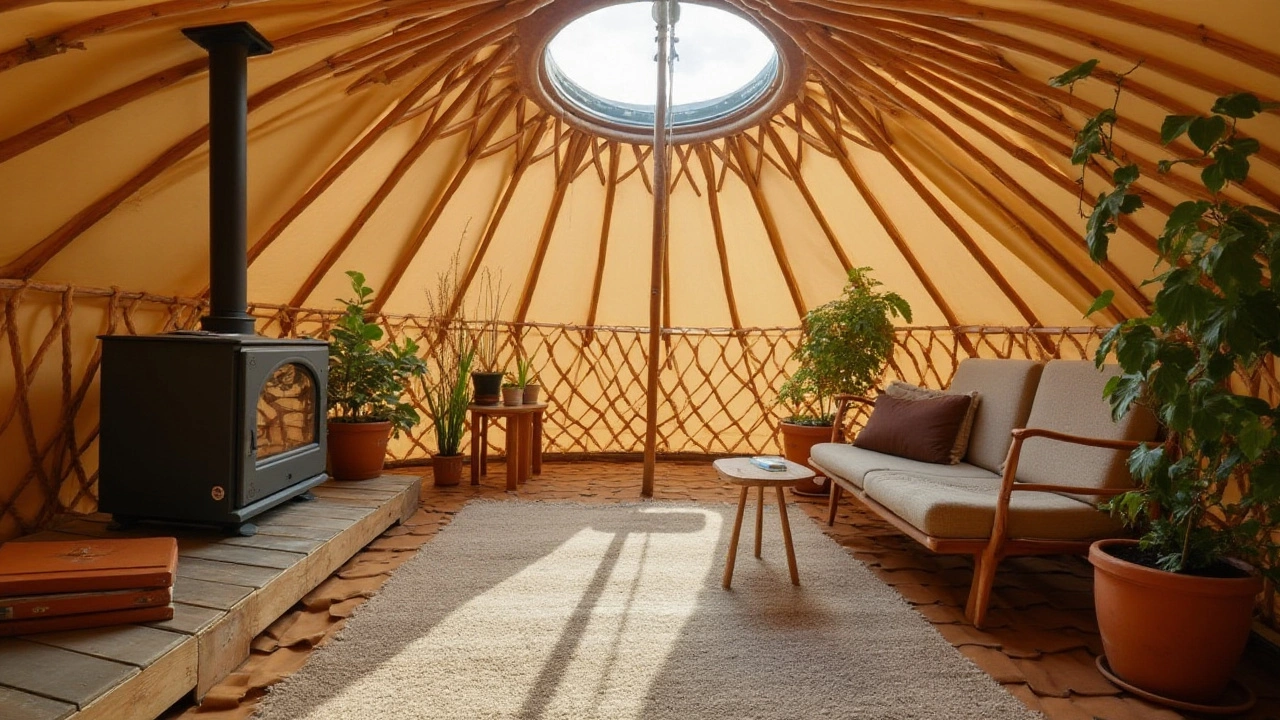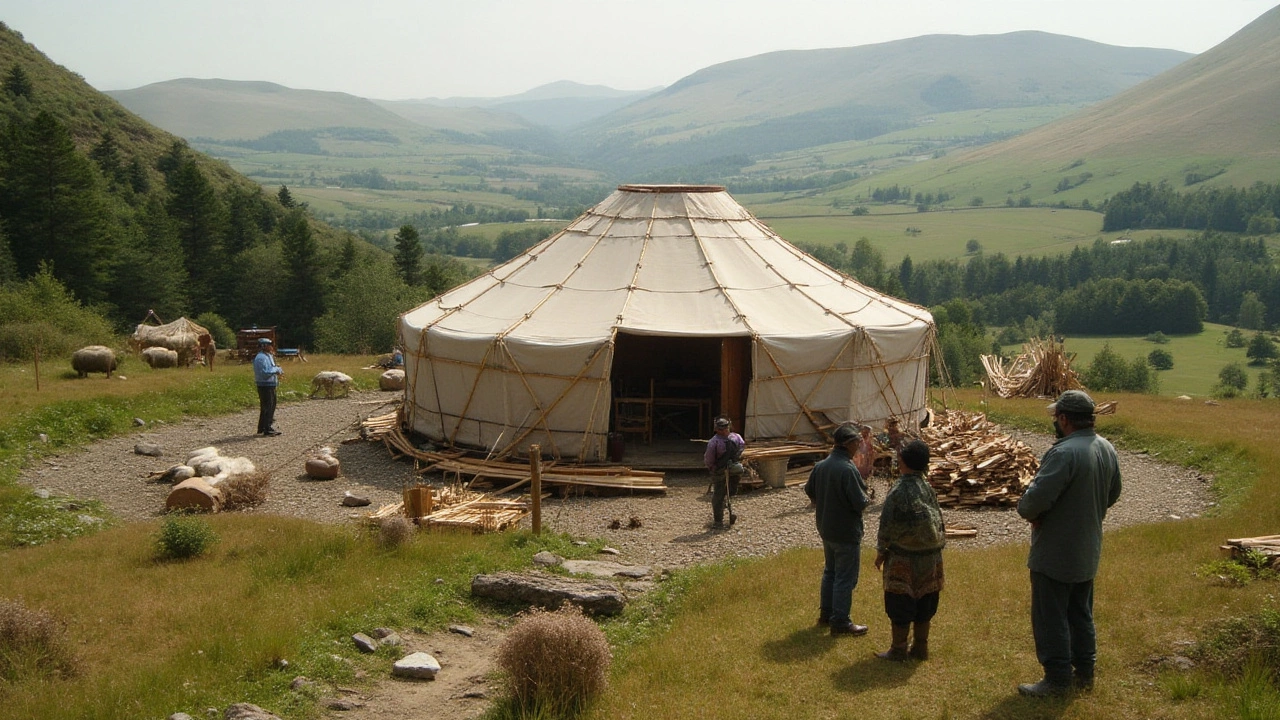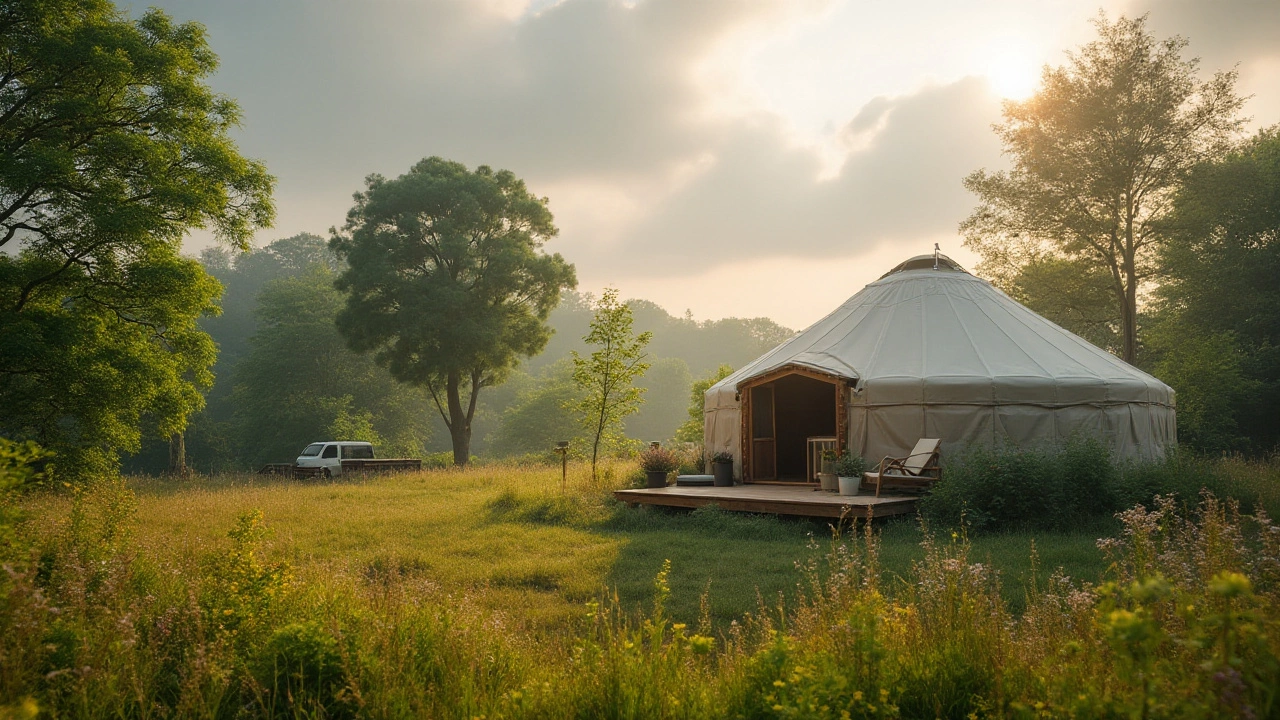Exploring the Eco-Friendliness of Yurts: A Sustainable Living Option
5 Jan, 2025Imagine living in a dwelling that not only embodies the beauty and simplicity of ancient practices but also aligns with modern ecological sensibilities. Yurts, these humble and inviting circular structures, have made their way from the vast steppes of Central Asia to the eco-conscious landscapes of today. As interest in sustainable living grows, more people are considering yurts as a viable, eco-friendly housing solution.
Constructed with a mindful approach to resource use, yurts boast a minimal carbon footprint due to their efficient design and environmentally friendly materials. Whether you're considering a yurt as a permanent residence or a peaceful retreat nestled in nature, it's worth exploring how these ingenious structures can contribute to a greener lifestyle.
- The Historical Roots of Yurts
- Modern Yurt Construction and Materials
- Insulation and Energy Efficiency
- Environmental Impact and Sustainability
- Maintenance Tips for Sustainable Living
- Yurt Living: Considerations and Lifestyle
The Historical Roots of Yurts
Long before they captured the imagination of modern eco-enthusiasts, yurts traced their origins to the nomadic tribes of Central Asia. These ingenious structures, known traditionally as "ger" to the Mongols, have stood the test of time for thousands of years. Their unique cylindrical shape allowed them to withstand the harsh winds of the steppes, while their portable design suited the itinerant lifestyles of the groups who lived off the land. Historical records from as far back as the 13th century describe yurts in the chronicles of explorers like Marco Polo, who documented the lives of these resilient tribes.
Intriguingly, the design of the yurt is intrinsically linked to its environment. The original inhabitants needed a home that was not only comfortable and safe, but also easily transportable. This need led to the development of a framework that could be dismantled and packed onto the back of a horse or camel. Materials like wood for the lattice walls and felt made from sheep wool for insulation were readily sourced from their surroundings, making the construction process sustainable and in harmony with the environment. This balance between man and nature has allowed the concept of the yurt to endure throughout history.
In fact, some historians argue that the success of the Mongol Empire in the 13th century – which at one point was the largest contiguous empire in history – can be partially attributed to the practicality and adaptability of their yurts. These structures allowed rapid mobility and quick setup, which were crucial for the Mongols’ military campaigns. A significant aspect of their design is that they did not require nails or screws, just simple yet effective tension and compression dynamics, which made them perfect for a seamless construction process.
As Sir John Man, author of "Genghis Khan: Life, Death, and Resurrection", puts it, "Their brilliance lay in their simplicity and they provided a model of living that has been scarcely improved upon since."
From an architectural perspective, the yurt presents a fascinating study of form meeting function. Its circular design is not only visually appealing but also highly functional, aiding in an even distribution of heat and weight and resisting adverse weather conditions with ease. These characteristics are what have made yurts a subject of interest among modern architects and sustainable living advocates. The ancient techniques have been refined and adapted, leading to a resurgence in popularity, particularly among those seeking an off-grid lifestyle.
Interestingly, the cultural significance of yurts stretches beyond their physical properties. To those who lived in them, they were more than just a structure; they were an integral part of their community and way of life. Ceremonies and rituals were often held within these intimate circular spaces, reinforcing social bonds and cultural identities. This has left an indelible mark on the architectural and anthropological history of Central Asia, illustrating how a dwelling can shape the lifestyle and culture of its people. The enduring legacy of the yurt is a testament to the timeless wisdom of our ancestors in creating sustainable, livable spaces.
Modern Yurt Construction and Materials
In the world of eco-conscious architecture, the yurt stands out as an appealing union of tradition and innovation. Its ancient design, traditionally used by nomadic tribes of Central Asia, has been reimagined with modern materials and techniques to suit today's environmental standards. Let's take a closer look at how these fascinating circular abodes are constructed and what materials make them an exceptional eco-friendly choice for sustainable living. The heart of a yurt's construction lies in its framework, typically constructed from lightweight and robust materials like bamboo or timber. These materials are often sourced sustainably, ensuring the yurt's eco-friendliness right from the outset. Bamboo, in particular, is a remarkable renewable resource; it grows quickly and requires minimal resources to cultivate, making it a preferred choice for eco-friendly homes. Meanwhile, the framework's lattice structure provides flexibility and strength, enabling the yurt to withstand various weather conditions, from windy plains to heavy snowfall.
Modern advancements have introduced a range of materials to enhance the durability and comfort of yurts. The outer covering, once traditionally made from felt or animal hides, is now often created using robust weather-resistant fabric—sometimes even recycled fibers—to ensure longevity without compromising ecological integrity. In addition to their outer shell, many yurts incorporate sophisticated insulation solutions to boost their energy efficiency. Insulating the walls, roof, and even the floor can dramatically reduce energy consumption by maintaining a stable interior temperature, which is crucial for both comfort and sustainability. Insulation materials range from natural wool to advanced eco-friendly polymers, each selected to minimize the yurt's environmental impact. According to Richard Atkin, a sustainable architecture expert, "Yurts represent an impressive blending of simplicity and high-tech ingenuity, enabling us to live harmoniously with nature."
In keeping with the principles of sustainable living, many yurt designers now incorporate renewable energy technologies into their construction. Solar panels and tiny wind turbines can be seamlessly integrated, providing an autonomous energy system that complements the off-grid appeal of these unique dwellings. Water conservation systems, such as rainwater collection setups, are also becoming an increasingly common addition, underscoring the commitment to reducing environmental footprints. Although often not included in traditional setups, modern yurts can easily accommodate underfloor heating systems, enhancing their suitability for year-round use, even in colder climates. Such innovations highlight the flexibility and adaptability of yurts, making them an attractive choice for a wide range of environments and lifestyles.
An interesting aspect of modern yurt construction is the possibility of personalization while maintaining sustainable practices. Some manufacturers offer custom designs, allowing dwellers to imbue their space with personal aesthetics and choose from a variety of earth-friendly building materials. Repurposed wood or reclaimed metal, for instance, can add unique character without leaning on unsustainable sourcing practices. Still, the circular, open-plan layout remains untouched, promoting a sense of community and connectedness within the living space. When considering the sustainable virtues of yurt living, it's essential to recognize the community of builders and architects dedicated to advancing these designs. A 2023 study highlighted that the market for portable and sustainable housing solutions like yurts is expected to grow by 15% in the coming years, driven by increasing awareness and a shift towards greener living solutions. Such progress serves as testimony to the enduring appeal and relevance of yurts in our quest for harmony with the earth.

Insulation and Energy Efficiency
Yurts are renowned for their unique ability to maintain a comfortable indoor climate regardless of the weather conditions outside. This is largely due to their efficient insulation and inherently energy-efficient design. Imagine a cold winter night where you’re inside, cozily warm, without the constant hum of heating systems. This is no fantasy with a well-built yurt. The structure’s circular form plays a significant role in conserving energy because the round shape naturally reduces heat loss and it promotes better air circulation, reducing the need for constant temperature adjustments. Additionally, the materials used in modern yurt construction have evolved to include advanced, eco-friendly insulation materials alongside traditional options like felt. Sustainable builders often use sheep’s wool or recycled denim, which are not only great non-toxic insulators but also biodegradable, enhancing the yurt's eco-friendly profile.
Most yurts today use a combination of reflective insulation and natural fibers. Reflective insulation, typically made from materials like aluminum foil, reflects radiant heat, keeping the yurt cooler in the summer and warmer in the winter. On the other hand, layers of dense wool or similar materials around the walls and roof trap heat, maintaining a stable internal environment. This dual method ensures maximum thermal efficiency, practically outsmarting the elements. Hawaii Yurts, a respected yurt manufacturer, notes that with as little as three inches of appropriate insulation, a yurt can maintain a comfortable temperature inside even when the climate outside swings to extremes.
"The combination of reflective insulation with natural fibers can improve a yurt's energy rating significantly, ensuring minimal heat loss," says David Raitt, an expert in sustainable architecture.
Another integral aspect of a yurt’s energy efficiency is its ability to harness natural light. The central dome of a yurt is not only an architectural marvel but also acts as a natural skylight, flooding the interior with daylight and reducing dependence on artificial lighting. Let’s not forget that less reliance on artificial lights means power savings. You can enhance this energy-saving aspect by using LED bulbs when additional lighting is needed. LED bulbs consume less electricity and have a longer lifespan, which fits perfectly with the sustainable living ethos of yurt life. Prospective yurt dwellers interested in privacy while maximizing light may consider lightweight, transparent materials for their coverings that still provide insulation.
Solar panels can be an excellent addition if you are really looking to take the energy efficiency of your yurt to the next level. Given the often remote and off-grid locations where many choose to set up their yurts, solar power allows you to be truly self-sufficient. Modern solar technology is becoming more accessible and affordable, making it feasible to generate enough power for daily needs without draining natural resources. For people living in areas with abundant sunshine, solar panels can supply most—if not all—energy requirements. However, be sure to conduct a thorough site analysis to ensure optimal placement for your solar setup.
In conclusion, when it comes to energy efficiency, yurts strike an impressive balance between ancient wisdom and modern technology. From innovative insulation techniques utilizing natural fibers and radiant barriers to the clever use of space and light, yurts minimize environmental impact while maximizing comfort. They present a compelling case for anyone seeking a contemporary lifestyle with minimal carbon footprint. By embracing ethical and efficient energy practices, yurt enthusiasts can enjoy a snug home with a significantly reduced environmental impact and energy costs—just one of the many perks of these versatile dwellings.
Environmental Impact and Sustainability
When we discuss the environmental impact of yurts, it's essential to consider the materials used in their construction. Traditionally, yurts are made from natural, renewable resources like wood for the lattice framework and canvas or felt made from animal wool. This approach not only respects traditional craftsmanship but also minimizes the reliance on non-renewable materials. The structure remains light on the land, requiring no significant excavation or foundation, unlike conventional buildings. This means that once removed, the landscape can recover with minimal footprint left behind, which is a crucial consideration for ecologically sensitive areas.
The simplicity of yurt construction directly correlates with their sustainability. Because these structures are often prefabricated, there's less waste generated on-site, reducing construction pollution. The transportation of materials can be optimized to decrease emissions since the components are lightweight and compact. Many modern yurts incorporate advanced features like solar panels and composting toilets, further enhancing their eco-friendly nature. A significant benefit is how yurts promote a minimalist lifestyle, encouraging residents to live with less and be more mindful of resource consumption. This alignment with sustainable principles makes them an attractive option for those looking to reduce their ecological footprint.
Energy Efficiency and Resource Management
Energy efficiency in yurts arises from their design as well as their materials. The round shape creates a natural airflow that helps with passive heating and cooling, reducing the need for artificial climate control. Insulating your yurt with eco-friendly materials can significantly increase energy efficiency. Many yurt owners opt for wool or reflective insulation to conserve heat during colder months, showing that traditional knowledge still holds value in modern settings. A wood stove for heating integrates seamlessly, offering a renewable heat source that complements the natural feel of yurt living.
"Yurts offer an elegant, efficient space uniquely suited to fostering connection with nature," says environmental architect John Little, "They remind us to appreciate our planet's resources sparingly and thoughtfully."
Water management is another important factor. Rainwater harvesting systems can be integrated into yurt setups due to the simple roof structure, making water conservation natural and efficient. Coupling this with greywater systems or composting solutions ensures that waste is minimal and managed sustainably. Moreover, as evidence of their robust sustainability, once a yurt's life cycle comes to an end, its materials can often be recycled or even reused, contributing to a circular economy model. This zero-waste philosophy ties deeply into what makes yurts a compelling choice for an eco-friendly living arrangement.

Maintenance Tips for Sustainable Living
Living sustainably in a yurt requires a few thoughtful maintenance practices. These unique structures, with their simple yet effective design, help reduce one's ecological footprint. To keep a yurt in good condition and to uphold its eco-friendly benefits, it's important to engage in regular upkeep. Regular inspections of the exterior fabric are crucial, ensuring there are no tears or signs of weather wear. Recoating the canvas with a protective solution enhances its lifespan and maintains water-resistant qualities. Keeping the skylight in prime condition is another essential task. It contributes significantly to natural light and ventilation while reducing energy dependence.
Consider the yurt's position and surrounding flora, as these factors influence its durability. Planting trees strategically can offer natural shading, thereby reducing heating or cooling needs. Maintaining the foundation, whether it's a simple deck or a concrete pad, is also vital. This base not only supports the yurt physically but plays a role in its insulation and energy efficiency. Be mindful of the localized ecosystem and non-invasive downspouts that funnel water sustainably into garden beds or water tanks.
A well-maintained yurt is a testament to a lifestyle that values harmony between necessity and nature, as noted by eco-architect Catherine Zuniga, "Yurts invite us to live more consciously with our environment, reflecting our personal commitment to planetary well-being."
Wood preservation inside a yurt often goes unheeded. Treating the internal wooden frames with natural oil preserves the woods' integrity and avoids chemical off-gassing. Managing the yurt's interior environment is just as essential as external maintenance. Circulation is key to preventing moisture build-up, which can lead to mold or mildew in the earthy-smelling fabrics. Window openings should be checked and maintained to balance air flow and temperature naturally. If you feature a heat source like a wood stove, routine cleaning and monitoring ensure maximum efficiency and safety.
Adopting a sustainable approach for maintenance not only prolongs the life of a eco-friendly home like a yurt but also aligns itself with the broader values of sustainable living. Bio-cleaners and homemade solutions for cleaning encourage a cleaner footprint, avoiding harsh chemical residues that can seep into the fabric or harm the surrounding habitat. Through these eco-conscious maintenance strategies, a yurt remains a beacon of sustainability and innovative living.
Yurt Living: Considerations and Lifestyle
Stepping into a yurt is like entering a small world unto itself, where simplicity and comfort meet an innate connection with nature. The experience of yurt living often attracts those who are looking for a sustainable lifestyle. But before committing to this unique way of life, there are several factors that potential yurt dwellers should consider. One must understand that while yurts provide a reduced environmental impact, they also demand a commitment to adapting to simpler, perhaps less conventional living conditions. The absence of segmented rooms and open floor plans means living in harmony with both people and nature.
Yurts, with their sustainable living aspects, often pique interest due to their eco-friendly reputation. Many yurts don't come equipped with modern conveniences you might find in traditional homes, such as central heating or extensive plumbing systems. Thus, you might need to creatively integrate alternative solutions, including solar panels for electricity or a composting toilet system. These elements not only emphasize an ecological footprint but also challenge inhabitants to think differently about resource consumption. Additionally, considerations like locations that allow for composting or have enough sunshine for panels matter significantly.
When it comes to location, the versatility of yurts shines through. Whether you choose to place your yurt in a serene forest glade, on a green rolling hill, or perhaps beside a tranquil lake, you have flexibility. Yet, with this diversity comes the requirement for a good foundation, as a poorly set-up yurt can succumb to moisture or instability. This foundational imperative extends to insulation considerations as well. Goods like sheep wool or recycled denim can often provide superior temperature stability, allowing residents to remain snug in the winter and cool during the sweltering summer months.
The unique benefits of yurt living extend beyond practicalities; it’s a lifestyle oriented towards communing with the environment. The circular design encourages a sense of unity and togetherness for its inhabitants. Many have noted their experiences living in yurts, like renowned environmentalist Sarah Bigo, who stated, "Yurt living aligns us closely with the rhythms of nature, fostering a greater appreciation and responsibility towards our surroundings." This sentiment captures the ethos of yurt living, where the structure serves as more than shelter—it becomes an integral part of the natural landscape itself.
For families and individuals alike, yurts provide a unique opportunity to live in harmony with the earth. While they are readily customizable to suit personal preferences, it's essential to acknowledge that they may not accommodate every modern luxury. Taking time to understand the nuances and potential challenges plays a significant role in preparing for this lifestyle. Despite their ancient origins, their potential to offer a harmonious and simple life is undeniably relevant in today's world.

 by
by